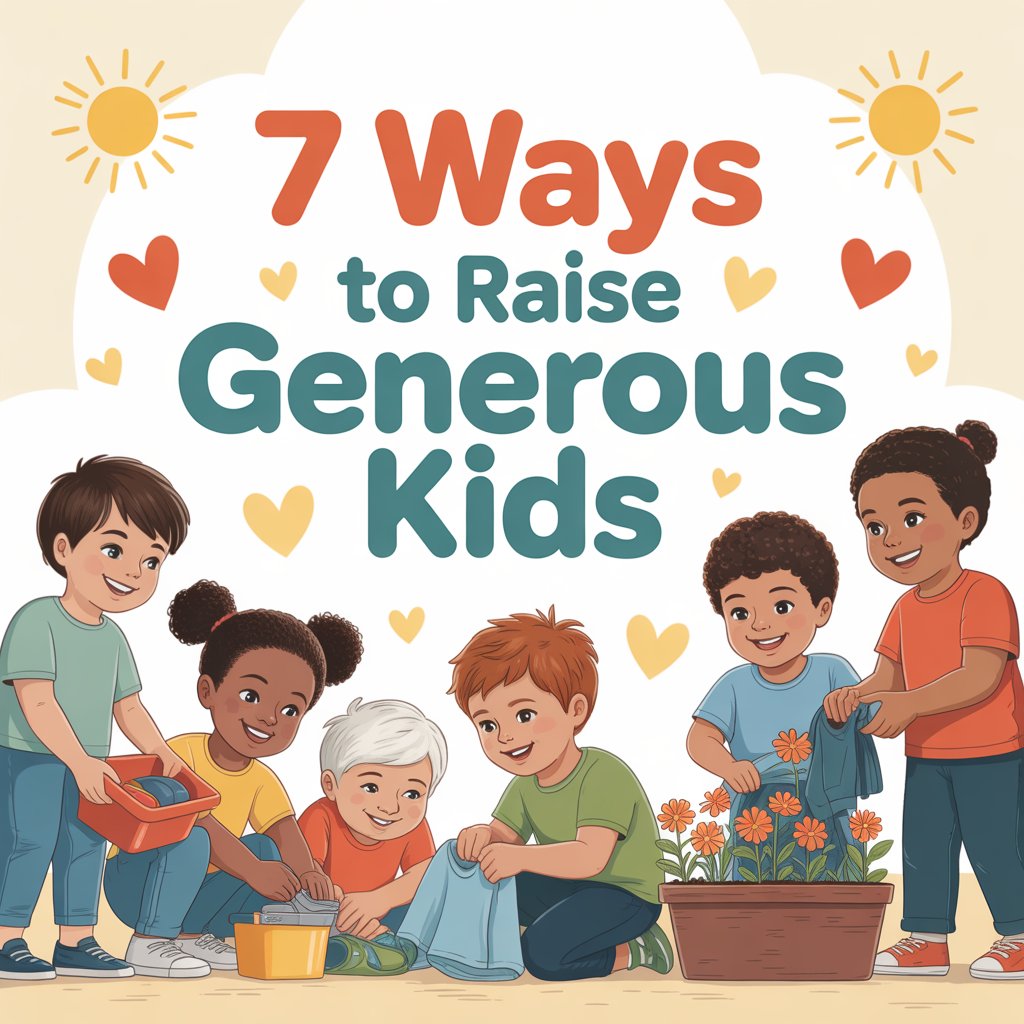7 Ways to Raise Generous Kids

Have you ever watched your child hold tightly to a favorite toy, refusing to share, or heard them ask, “Why do we have to give?” It’s a moment every parent can relate to. As much as we want our kids to be kind and generous, the truth is, giving doesn’t always come naturally.
We live in a world that often says, “Take care of yourself first.” Everywhere our children look, they see messages about getting more, having more, and being more. That’s why teaching generosity can feel like swimming against the current. But as Christian parents, we know that generosity isn’t just about money or gifts. It’s about reflecting the heart of God, who gives freely and loves unconditionally.
The Bible reminds us in Acts 20:35, “It is more blessed to give than to receive.” When our children understand that giving brings joy, not loss, they begin to see generosity as a privilege, not a chore.
In this post, we’ll look at seven practical and faith-filled ways to help your children grow into cheerful givers. You’ll also discover how simple tools like the Glory Prayer Box, Prayer Cards, and Journal can make generosity a natural and joyful part of your family’s everyday life.
Generosity from a Biblical Perspective
Generosity is much more than giving money or gifts. It’s about sharing your time, kindness, and compassion with others. True generosity comes from the heart — it’s choosing to give because God first gave to us. When children begin to understand that everything they have is a gift from God, they learn that giving is simply passing that love forward.
Teaching generosity matters because it shapes how children see the world. Kids who grow up learning to give become more grateful, compassionate, and content. They learn that happiness doesn’t come from having more but from helping others and making a difference in small ways.
You can start by talking with your kids about what generosity means in everyday life. Explain that it doesn’t always have to be about money. It can look like:
-
Helping a friend with homework.
-
Donating clothes or toys to another child.
-
Praying for someone who is going through a hard time.
Remind them that God is pleased when we give with joy, not because we have to. The Bible says in 2 Corinthians 9:7, “God loves a cheerful giver.”
To make this lesson more personal, use your Glory Prayer Box Journal as a family. Each week, write down one way your family plans to give back, whether through an act of kindness, service, or prayer and thank God for the chance to bless others.
-
Model Generosity Yourself
Children often learn more from what they see than from what they hear. If your kids see you giving freely and joyfully, they’ll begin to understand that generosity is a natural part of life, not just something you do occasionally. The best way to teach generosity is to live it out every day.
Here are a few simple ways to show it:
-
Let them see you give. Whether you’re donating clothes, helping a neighbor, or giving an offering at church, invite your children to be part of the moment.
-
Talk about why you give. Share with them that giving is your way of showing love and gratitude to God.
-
Celebrate small acts of kindness. When you notice your child sharing or helping someone, point it out and praise that behavior. It reinforces that generosity is valuable and rewarding.
The Bible reminds us in Luke 6:38, “Give, and it will be given to you.” This verse teaches that generosity brings blessings — not just material ones, but the joy and peace that come from giving with a sincere heart.
To make these moments more meaningful, record your family’s giving experiences in your Journal. Write down what you did, how it felt, and how you saw God’s faithfulness through it. Over time, your journal will become a beautiful reminder of how giving brings joy and draws your family closer to God.
-
Start Small and Make Giving Tangible
Generosity doesn’t have to start big. In fact, it’s often the small, simple acts that teach children the most. Kids understand giving better when they can see and feel what it means. The goal is to make generosity part of their everyday life in ways they can relate to.
Here are a few easy ways to start:
-
Create a “giving jar.” Encourage your child to put aside a small part of their allowance or gift money to help others. When the jar fills up, decide together where to give — maybe to church, a friend in need, or a local charity.
-
Donate gently used items. Go through toys, books, or clothes together and talk about how those items can bless another family.
-
Make handmade gifts. A drawing, a card, or a small craft can brighten someone’s day. It shows that giving isn’t just about money, but about love and thoughtfulness.
You can share the story from Mark 12:41–44, where Jesus honors the widow who gave two small coins. It reminds children that God values the heart behind the gift more than the amount given.
-
Teach the Joy of Serving Others
Generosity isn’t just about giving money or gifts. One of the most powerful ways to raise generous kids is by teaching them to give their time and energy. When children learn to serve others, they begin to see the world through God’s eyes — with compassion, love, and humility.
Here are a few simple ways to teach this:
-
Serve together as a family. Look for opportunities to volunteer at church, visit a nursing home, or help out at a local charity. Kids often learn best by doing, and serving alongside you shows them what generosity in action looks like.
-
Encourage helping at home. Remind your children that generosity begins right where they are. Helping a sibling, cleaning up after dinner, or offering to help without being asked are small but meaningful ways to practice a giving spirit.
-
Talk about why serving matters. Explain that serving is a way to show love — both to people and to God. It’s not about recognition, but about sharing God’s heart with others.
You can share Galatians 5:13, which says, “Serve one another humbly in love.” This verse reminds your child that serving is one of the purest forms of generosity.
After each family service activity, take time to reflect together. Use your Glory Prayer Box Journal to write down gratitude notes — what you enjoyed, what you learned, and how you saw God work through your act of service. Over time, these memories will remind your children that giving and serving bring joy, peace, and purpose.
-
Talk About Why We Give
Children are naturally curious, and when it comes to giving, they often want to know why it matters. Helping them understand the reason behind generosity turns giving from an obligation into an act of love.
Start by having honest and simple conversations about giving. Explain that we give because God gave to us first — His love, His blessings, and even His Son. When we give to others, we’re reflecting that same love to the world around us.
Here are a few ways to make these lessons come alive:
-
Share Bible stories about giving. Read stories like the Good Samaritan or the boy who shared his five loaves and two fish. Talk about how their hearts of generosity made a difference.
-
Connect giving to God’s love. Explain that when we give, it’s a way of showing gratitude for all that God has done.
-
Ask reflective questions. Encourage your kids to think deeper by asking, “How do you think giving makes God feel?” or “How does it make you feel when someone gives to you?”
You can share Matthew 6:21, which says, “For where your treasure is, there your heart will be also.” This helps children see that giving is not just about what’s in our hands, but what’s in our hearts.
As a family, you can use your Glory Prayer Box Journal to write down moments when you chose to give and how it made you feel. Over time, your children will begin to understand that giving is not about losing something, it’s about gaining joy, love, and connection with God.
-
Celebrate Acts of Kindness
Children thrive on encouragement, and when you celebrate their acts of kindness, it helps those values take root in their hearts. Celebration doesn’t always mean giving rewards—it’s about recognizing the heart behind their actions and showing them that generosity brings joy.
You can make kindness part of your family’s rhythm by being intentional about noticing and affirming it. When your child shares a toy, helps a sibling, or comforts a friend, pause and celebrate that moment. Tell them, “That was such a kind thing to do,” so they connect generosity with love and joy.
Here are a few simple ways to celebrate kindness in your home:
-
End each week by sharing one kind or generous thing each family member did. This helps everyone reflect on how God used them to bless others.
-
Keep a “Kindness Jar.” Write down acts of kindness on small slips of paper and place them in the jar. Read them together at the end of the month as a family reminder of how love in action looks.
-
Praise effort, not just results. Celebrate the heart to give, even if the outcome isn’t perfect.
You can also tie this to Scripture, using Hebrews 10:24, which says, “Let us consider how we may spur one another on toward love and good deeds.” This verse reminds your family that kindness inspires more kindness, it spreads like light.
To make it even more meaningful, turn your Glory Prayer Box into a Family Praise Box. Use it to collect stories of generosity, answered prayers, and moments when God worked through your family’s giving. Over time, it becomes a beautiful record of God’s faithfulness and your family’s growing heart for kindness.
-
Teach Gratitude Alongside Generosity
Gratitude and generosity are deeply connected. When children learn to appreciate what they have, they become more willing to share with others. A thankful heart naturally gives because it recognizes that everything we have comes from God.
You can begin teaching this by showing what gratitude looks like in everyday life. Let your kids see you thank God for small things, like a sunny day or a good meal. Help them understand that being thankful isn’t just for special occasions—it’s a daily attitude that opens the heart to give.
Here are a few ways to practice gratitude together:
-
Start a family gratitude list in your Glory Prayer Box Journal. Write down blessings, big or small, and revisit them at the end of the week to remind everyone how faithful God has been.
-
Encourage thank-you notes when they receive gifts or kindness from others. This helps them connect appreciation with relationships.
-
Pray together as a family and thank God for daily provisions—food, family, friends, and even challenges that help you grow.
You can tie this to 1 Thessalonians 5:18, which says, “Give thanks in all circumstances.” This verse reminds children that thankfulness is not about having everything they want but about recognizing God’s goodness in every season.
When gratitude becomes a habit, generosity follows naturally. Children who are thankful grow up to see giving not as a burden but as a joyful expression of love and faith.
-
Pray Together for a Generous Heart
Prayer is where true generosity begins. When you pray as a family, you’re reminding your children that giving is not just something we do, it’s something God grows inside of us. He is the ultimate giver, and prayer helps us align our hearts with His.
Make it a family habit to talk to God about generosity. Let your children hear you thank Him for what you have and ask Him to show you ways to bless others. Prayer softens hearts, strengthens compassion, and keeps your focus on what truly matters.
Here are a few ways to make it practical:
-
Pray for opportunities to give and serve. Ask God to open doors for your family to share kindness, time, or resources with others.
-
Pray for cheerful hearts. Ask God to help everyone give with joy, not out of guilt or pressure.
-
Include specific people or needs during prayer time. This helps children connect giving with real people and real stories.
You can share Psalm 51:10, which says, “Create in me a pure heart, O God.” This verse reminds your children that generosity begins with a heart that’s right before God.
Conclusion
Raising generous kids goes far beyond teaching them to give things away. It’s about nurturing hearts that reflect God’s love, kindness, and compassion in everything they do. When children learn that generosity is rooted in God’s character, giving becomes a natural expression of faith and gratitude.
Your everyday actions, prayers, and conversations are shaping how your children see giving. Each time you model kindness, share with someone in need, or thank God for His blessings, you are planting seeds of generosity that will grow for a lifetime. Remember, generosity is contagious. When your children see you give joyfully, they learn that giving is not a duty but a privilege.


